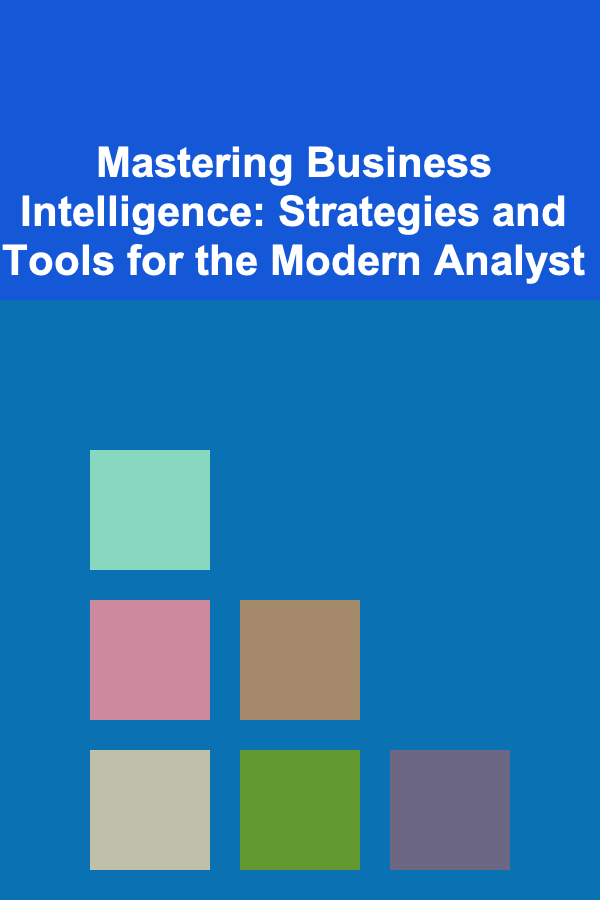
Mastering Business Intelligence: Strategies and Tools for the Modern Analyst
ebook include PDF & Audio bundle (Micro Guide)
$12.99$10.99
Limited Time Offer! Order within the next:

In today's data-driven world, business intelligence (BI) has become an essential component for organizations looking to gain a competitive edge, optimize operations, and improve decision-making processes. BI is no longer a luxury; it's a necessity that empowers businesses to leverage their data to drive strategy, innovation, and growth.
For modern analysts, mastering BI is not just about knowing how to use tools; it's about adopting the right strategies and methodologies that enable data to be transformed into actionable insights. This guide will explore key strategies, tools, and best practices that can help analysts effectively master business intelligence and deliver value to their organizations.
Understanding the Role of Business Intelligence
Business intelligence involves a range of technologies, processes, and practices that allow businesses to collect, analyze, and present data in ways that lead to informed decisions. BI covers everything from basic data reporting to complex predictive analytics, helping organizations uncover patterns, trends, and insights that drive decision-making.
However, the role of a BI analyst goes beyond simple reporting. Modern BI analysts are tasked with turning raw data into valuable insights, using data-driven narratives to inform strategic initiatives, and utilizing advanced analytics techniques to predict future trends. To do this effectively, analysts need to be well-versed in both the technological tools and the strategic approaches that drive BI success.
Key Strategies for Mastering Business Intelligence
1. Align BI with Business Objectives
One of the most fundamental strategies for mastering business intelligence is to ensure that BI efforts are aligned with the broader business goals of the organization. Without clear alignment, BI can become a disjointed effort, focused on gathering data and generating reports that don't truly inform decision-making.
How to align BI with business objectives:
- Engage with stakeholders: Work closely with business leaders to understand their pain points, challenges, and goals. Whether they're looking to increase revenue, reduce costs, or improve customer satisfaction, BI strategies should be focused on solving these specific challenges.
- Focus on actionable insights: Don't just generate data. Focus on what the data means and how it can drive action. Provide insights that are not only relevant but also actionable, helping the business move toward its goals.
- Prioritize business-critical metrics: Identify the key performance indicators (KPIs) that matter most to your organization and use BI to track and measure these metrics effectively.
2. Invest in Robust Data Management Practices
The quality of data is central to the success of any BI initiative. Without clean, accurate, and reliable data, BI insights will be flawed and unreliable. Therefore, modern analysts must ensure that data management practices are robust and that data is organized, governed, and easily accessible.
Key components of data management:
- Data governance: Establish data governance policies to ensure that data is properly structured, maintained, and secured. Define data ownership, access protocols, and standards for data quality.
- Data integration: Integrate data from various sources, including internal systems (CRM, ERP, etc.), external datasets, and third-party tools. BI tools need to pull data from a variety of sources, so integration is critical.
- Data cleaning: Implement processes for cleaning and standardizing data to remove inconsistencies and duplicates. Data quality is crucial for producing reliable, actionable insights.
3. Embrace Self-Service Business Intelligence
In the past, BI was often the domain of data analysts and IT departments. However, with the rise of self-service BI tools, modern organizations are empowering their employees to access and analyze data without needing technical expertise.
Benefits of self-service BI:
- Faster decision-making: Business users can generate reports and insights on demand, without waiting for IT or analysts to create custom reports.
- Increased adoption of BI: By providing intuitive tools, self-service BI encourages broader adoption across the organization. It democratizes data access, allowing decision-makers at all levels to leverage data for their own needs.
- Greater flexibility: Self-service BI tools allow users to create custom reports, dashboards, and analyses tailored to their specific needs.
To implement self-service BI effectively, analysts must choose user-friendly BI tools and provide training and support to empower business users. Analysts should also establish guidelines to ensure that self-service tools are used correctly and that data integrity is maintained.
4. Utilize Predictive and Prescriptive Analytics
While traditional BI focuses on descriptive analytics (what has happened), modern BI also includes predictive and prescriptive analytics, which help businesses forecast future trends and recommend actions to optimize outcomes.
Key approaches:
- Predictive analytics: This involves using historical data and statistical models to predict future outcomes. For example, an analyst might use predictive models to forecast customer churn or sales trends. Tools such as machine learning algorithms and regression models are often used in this approach.
- Prescriptive analytics: Once predictive analytics have identified likely outcomes, prescriptive analytics recommend actions to optimize results. For instance, if predictive analytics indicate a decline in sales, prescriptive analytics might suggest targeted marketing campaigns or pricing adjustments to mitigate the decline.
By incorporating predictive and prescriptive analytics into BI strategies, analysts can provide not only insights into past performance but also actionable recommendations for improving future results.
5. Focus on Data Visualization and Storytelling
Data visualization plays a crucial role in BI because it enables analysts to present complex data in an easy-to-understand format. A well-designed visualization can reveal insights that would otherwise be difficult to comprehend from raw data alone.
Best practices for data visualization:
- Choose the right visualization type: Different types of data require different visualizations. For example, use line charts to show trends over time, bar charts to compare categories, and pie charts for proportions.
- Keep it simple: Avoid cluttering your visualizations with unnecessary details. Focus on key metrics and trends to make the insights more digestible.
- Interactive dashboards: Interactive dashboards allow users to explore data dynamically, drill down into specific details, and filter metrics based on their needs.
- Data storytelling: Present data in a narrative format that tells a story. Instead of just showing numbers and charts, explain what the data means and how it can guide decision-making. A strong narrative makes the data more relatable and easier for stakeholders to understand.
6. Foster a Data-Driven Culture
BI is most effective when it's embedded into the organization's culture. A data-driven culture ensures that data isn't just an afterthought or something that's only used by analysts and IT; it becomes an integral part of every decision made across the organization.
How to foster a data-driven culture:
- Lead by example: Leaders should champion the use of data in decision-making. When top management uses data to guide decisions, it encourages others to do the same.
- Promote data literacy: Equip employees with the knowledge and skills to understand and analyze data. This includes offering training programs, workshops, and resources that teach basic data skills and the importance of data-driven decision-making.
- Make data accessible: Ensure that data is easy to access, interpret, and act upon. Provide employees with the right tools and resources to make data-driven decisions.
- Encourage collaboration: Data should be shared across departments, allowing teams to collaborate and leverage insights from different areas of the business.
7. Stay Agile and Continuously Improve
Business intelligence is not a one-time project; it is an ongoing process that requires constant evaluation and adaptation. The needs of the business change over time, and the tools and technologies used for BI continue to evolve as well.
How to stay agile:
- Iterate on BI processes: Continuously review and improve BI processes to ensure that the organization is getting the most value from its data.
- Monitor performance: Regularly assess the effectiveness of BI initiatives using KPIs and feedback from business users.
- Stay up to date with trends: BI technologies evolve rapidly. Stay informed about emerging trends like artificial intelligence, machine learning, and augmented analytics, and incorporate these innovations into your BI strategy as appropriate.
Essential BI Tools for the Modern Analyst
To implement the strategies outlined above, analysts must choose the right BI tools. Here are some of the most popular and effective BI tools currently available:
1. Tableau
Tableau is a powerful data visualization tool that allows users to create interactive and shareable dashboards. Its drag-and-drop interface makes it accessible for non-technical users while still offering advanced analytics capabilities for more experienced analysts.
2. Power BI
Microsoft Power BI is another popular BI tool that integrates seamlessly with other Microsoft products. It's known for its ease of use, robust reporting features, and affordability. Power BI is especially suited for organizations that already rely on Microsoft Office or Azure.
3. Looker
Looker is a cloud-based BI platform that focuses on creating a data model that can be used to build custom dashboards and reports. It is highly flexible and is ideal for organizations looking to create personalized, data-driven applications.
4. Qlik Sense
Qlik Sense is a self-service BI tool that emphasizes data discovery and associative analytics. It enables users to explore data freely, making it ideal for organizations that want to empower employees to uncover insights on their own.
5. Google Data Studio
Google Data Studio is a free, cloud-based BI tool that allows users to create reports and dashboards. It integrates well with Google Analytics, Google Ads, and other Google tools, making it an excellent option for companies already using the Google ecosystem.
Conclusion
Mastering business intelligence is about more than just understanding how to use BI tools---it's about developing strategies that align with business goals, ensuring high-quality data management, and fostering a culture of data-driven decision-making. By leveraging the right strategies, tools, and best practices, modern analysts can transform data into powerful insights that drive business success.
As organizations continue to accumulate vast amounts of data, the demand for skilled BI professionals will only grow. By staying informed about the latest trends and continuously honing your skills, you can become a key player in your organization's journey toward data-driven success.
Reading More From Our Other Websites
- [Home Pet Care 101] How to Maintain a Pet-Friendly Home During the Holidays
- [Home Staging 101] How to Avoid Common Home Staging Mistakes
- [Personal Care Tips 101] How to Choose a Perfume for Your First Date
- [Hiking with Kids Tip 101] Best Strategies for Managing Hiking Gear Weight When Trekking with a Baby Carrier
- [Organization Tip 101] How to Create a Smartphone App System for Home Tasks
- [Personal Care Tips 101] How to Get the Best Shaving Cream Lather for an Effortless Shave
- [Organization Tip 101] How to Organize Specialty Cooking Tools for Quick Access
- [Home Space Saving 101] How to Create a Functional Entryway in Limited Space
- [Personal Investment 101] How to Understand and Use Investment Risk Tolerance
- [Home Holiday Decoration 101] How to Create a Cozy, Hygge-Inspired Holiday Decor

How to Choose the Right Art Pieces for Staging Your Home
Read More
How to Incorporate Technology Organizers in Your Family Room
Read More
How to Organize Your Home Office for Productivity
Read More
How to Simplify Your Finances with a Simple Budget App
Read More
The Benefits of Cutting Down on Alcohol and Tobacco Expenses for Your Health and Wallet
Read More
How to Reduce Emissions from the Energy Sector
Read MoreOther Products

How to Choose the Right Art Pieces for Staging Your Home
Read More
How to Incorporate Technology Organizers in Your Family Room
Read More
How to Organize Your Home Office for Productivity
Read More
How to Simplify Your Finances with a Simple Budget App
Read More
The Benefits of Cutting Down on Alcohol and Tobacco Expenses for Your Health and Wallet
Read More